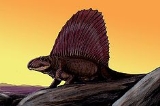
Dimetrodon
Overview
Dimetrodon was a predatory synapsid
genus
that flourished during the Permian
period, living between 280–265 million years ago (during the Artinskian
to Capitanian
stages).
As a synapsid it was more closely related to mammal
s than to true reptile
s such as lizard
s and snakes. It is classified as a pelycosaur
. Fossil
s of Dimetrodon have been found in North America
and Europe
. Dimetrodon had a sail on its back, which is thought to have been used for regulating body temperature, or for display.
Dimetrodon was one of the largest land animals and the apex predator of its time.
Synapsid
Synapsids are a group of animals that includes mammals and everything more closely related to mammals than to other living amniotes. They are easily separated from other amniotes by having an opening low in the skull roof behind each eye, leaving a bony arch beneath each, accounting for their name...
genus
Genus
In biology, a genus is a low-level taxonomic rank used in the biological classification of living and fossil organisms, which is an example of definition by genus and differentia...
that flourished during the Permian
Permian
The PermianThe term "Permian" was introduced into geology in 1841 by Sir Sir R. I. Murchison, president of the Geological Society of London, who identified typical strata in extensive Russian explorations undertaken with Edouard de Verneuil; Murchison asserted in 1841 that he named his "Permian...
period, living between 280–265 million years ago (during the Artinskian
Artinskian
In the geologic timescale, the Artinskian is an age or stage of the Permian. It is a subdivision of the Cisuralian epoch or series. The Artinskian lasted between 284.4 ± 0.7 and 275.6 ± 0.7 million years ago...
to Capitanian
Capitanian
In the geologic timescale, the Capitanian is an age or stage of the Permian. It is also the uppermost or latest of three subdivisions of the Guadalupian epoch or series. The Capitanian lasted between and...
stages).
As a synapsid it was more closely related to mammal
Mammal
Mammals are members of a class of air-breathing vertebrate animals characterised by the possession of endothermy, hair, three middle ear bones, and mammary glands functional in mothers with young...
s than to true reptile
Reptile
Reptiles are members of a class of air-breathing, ectothermic vertebrates which are characterized by laying shelled eggs , and having skin covered in scales and/or scutes. They are tetrapods, either having four limbs or being descended from four-limbed ancestors...
s such as lizard
Lizard
Lizards are a widespread group of squamate reptiles, with nearly 3800 species, ranging across all continents except Antarctica as well as most oceanic island chains...
s and snakes. It is classified as a pelycosaur
Pelycosaur
The pelycosaurs are an informal grouping composed of basal or primitive Late Paleozoic synapsid amniotes. Some species were quite large and could grow up to 3 meters or more, although most species were much smaller...
. Fossil
Fossil
Fossils are the preserved remains or traces of animals , plants, and other organisms from the remote past...
s of Dimetrodon have been found in North America
North America
North America is a continent wholly within the Northern Hemisphere and almost wholly within the Western Hemisphere. It is also considered a northern subcontinent of the Americas...
and Europe
Europe
Europe is, by convention, one of the world's seven continents. Comprising the westernmost peninsula of Eurasia, Europe is generally 'divided' from Asia to its east by the watershed divides of the Ural and Caucasus Mountains, the Ural River, the Caspian and Black Seas, and the waterways connecting...
. Dimetrodon had a sail on its back, which is thought to have been used for regulating body temperature, or for display.
Dimetrodon was one of the largest land animals and the apex predator of its time.
Discussions

